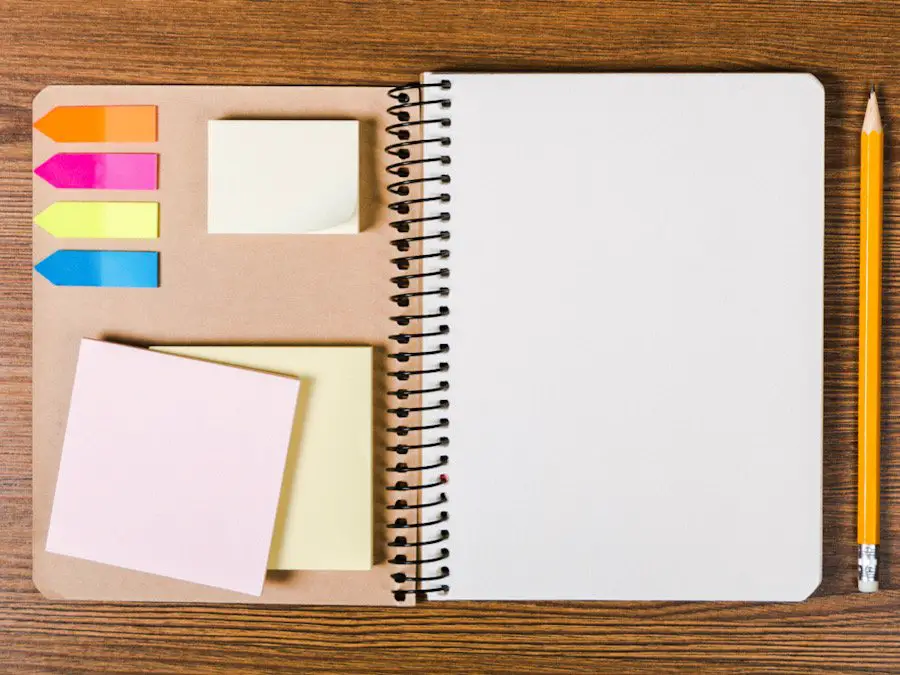Are you ready to start a new journaling habit? One of the first decisions you need to make is between writing vs. typing. Should you journal on the computer? Or by using paper? Many get stuck on understanding what will give them the greatest benefits. This is a fairly personalized decision you’ll need to make. It will be easier if you know what your goals are for journaling.
If you’re looking to improve your mental clarity and focus, you may do better with the distraction-free simplicity of paper journaling. If you’re looking for a convenient option that lets you catalog your journal entries and make them searchable, you may need a digital journal. Of course, there are a lot more considerations than this.
In this article, we’ll look at the advantages and disadvantages of both paper and digital journaling. We’ll also look at the tools you can use for each. If you’re still stuck, we’ll go through how to make this decision for yourself.
Table of Contents
The Pros and Cons of Computer Vs Paper For Journaling
At the end of the day, journaling is better than not journaling. You can always try one of these methods, see how it’s going for you, and adjust. So don’t let making this decision stress you out.
In the true fashion of someone who loves journaling, and especially writing lists, let’s work on making this initial decision by going over the pros and cons of writing vs typing for your new journaling habit.
Keep in mind that these pros and cons will vary for you personally. They will also change a lot based on your intentions for journaling. Many people may find that a paper journal works best for expressing their feelings, while a digital journal may work best for organizing their days—or vice versa.
Always remember it’s okay to keep more than one journal if that’s what works for you.
The Pros of Journaling on Paper

- You can avoid distractions. Many people find that journaling is a time for them to clear their minds and focus their thoughts. Taking the time to do this carries into another part of their day, making them less tempted to jump into the latest and greatest thing to cross their paths. However, it’s harder to gain that focused state of mind from journaling if you’re interrupted by alerts on your device as you write. With a paper journal, you can give yourself some time away.
- You can cut down on your screen time. If you’re trying to journal before bed and avoid blue light during those hours, keeping a paper journal is a new habit that can really make those goals easier for you.
- Your paper journal will never have technical difficulties.
- There’s freedom for creativity on paper that doesn’t require you to learn any new skills. This freedom can encourage you to draw out an idea, create a mind map, journal in lists, doodles, or use stickers. While you may not think you want to do any of those things today, the more you journal, the more you open yourself up to those opportunities to keep your journaling fresh and engaging for yourself.
- It will keep you from editing. The backspace button is too tempting and easy to access on a computer. While you can always cross lines out in a paper journal, you’re less likely to do so. And yes, this is a good thing. When you’re journaling, you want to leave your perfectionist side at the door. This is an activity you’re doing for yourself. If you want to know what you really think, you need to give yourself the freedom to write freely.
The Cons of Journaling on Paper
- You don’t currently carry a paper journal with you everywhere you go. Is that likely to become a habit for you? If not, then it may be a significant disadvantage to not have your journal with you when you have a new idea you want to write down or when you need to check something on one of your lists.
- There is no second copy. Paper journals can last for centuries, or they can get damaged by water or torn or otherwise ruined.
- You can’t put a password on your paper journal to protect it. You can keep it locked in a safe, but that’s not very convenient for use. Being able to know and trust that no one will read your journal is important. If you’re writing lists, you don’t want other people invading your personal planner. If you’re writing to express your feelings, you’ll have difficulty sharing your truth if you can’t trust it will stay private.
- You go slower at first. This last one is only a negative when you’re getting started, but it certainly stops a lot of people. Most of us don’t write by hand anymore. You know how to type. When you start writing by hand a lot, you’ll be slower than usual. Your hand may cramp. It will feel awkward. Your relationship with paper will develop over time. Most people come to love that relationship. But until that happens, it’s surprisingly awkward to start writing by hand.
The Pros of Digital Journaling

- You can access it from anywhere. Are you one of the millions of people who always have their phones on them? Then you already have the habit of keeping your journal nearby if you’re doing so digitally. If you use an app or even Google docs, you can access your online journal via any device.
- Digital journal entries are searchable. Have you ever tried reading a paper book and found yourself ready to hit ctrl+f? It’s more common than you’d think. We’re used to being able to easily search for things now. You can search for entry dates or a person’s name to see every time they’re mentioned.
- In many journaling apps, you can add tags. This makes it easy to group all of your entries that have grocery lists or ideas for your next vacation.
- You can use a secure password to protect your journal.
- You are already used to typing. This makes it more natural in the beginning if you’re not used to writing by hand. This is also faster for most people today.
- You can make it multimedia. Do you want to add a video of your day to your journal? At the end of a long day, would you like to journal by simply saying what has happened instead of writing it down? With a digital journal, you can record audio, video, or add photos to your entries.
- You can create a backup system for your digital journal to keep it safe.
The Cons of Digital Journaling
- While it’s convenient that you can journal from any device, you are subject to technical failures. What if your wifi goes down? What if your battery dies? What if the application you’re using to journal goes down? These are all struggles that likely don’t come up too often, but when they do, they’re terrible. We use journals to help express ourselves and to better maintain and control our lives. When you don’t have access to your journal due to technical difficulties, it can feel surprisingly stressful.
- If you’re trying to avoid blue light in the evenings, you’ll probably need to wear some blue light blocking glasses while you journal. You don’t need to spend a fortune, though. We’ve compiled a list of the best blue light blocking glasses under $50. In any case, if you’re looking at screens most of the day, journaling is another activity that may contribute to eye strain. For most of us, getting any time off-screen is valuable. Digital journaling adds one more activity you need to do while looking at a screen.
- The distractions! You can do things to minimize this. For example, you can put on “do not disturb,” use an app like Freedom to block yourself from social media or other distracting websites, and do your best to stay focused. Despite these measures, it is still very easy to get distracted when you’re on a device.
- You don’t have a personal connection to your digital journal the way you would with a paper one. It sounds cheesy, but you’ll develop a personal relationship with your paper journal. You’ll look at your own handwriting, you’ll write slowly and remember the experience, and you’ll pick out a new journal with a fresh cover every time you fill one up. The physical connection with a paper journal becomes personal. Digital journaling can be less personal.
- You may have issues with proprietary formats. If you use a journaling app that keeps your digital entries in a format unique to that app, you won’t be able to open your own journal in anything else. If that app goes down, you lose your journal. Make sure to choose a digital format journal where you can download your journal to back it up in a standard format, like a .doc or .pdf.
Writing vs Typing: How to Choose

Let’s break this down with some common struggles people experience as they’re trying to make this decision.
Do you know why you want to journal? Not knowing why you want to journal can make it difficult to know which method would be best for you. Are you looking to journal so you can get more in touch with yourself? Paper journaling is often best for this. Do you want to create a searchable record of your days? Then digital journaling may work best for you. If you read through the pros and cons of computer vs. paper journaling with your end goal in mind, it can become more apparent which method best suits your personal needs.
Do you have more than one goal for your journaling? Are you looking to journal to plan your days, but then also to recount them? You may want to keep a bullet journal on paper as a planner and then type out entries about your day in an app. Or you may want to keep a digital journal with your organized lists, and then write about your day and your feelings on paper. This is about what feels right to you.
What time of day will you be journaling? Sometimes, approaching your new habit in this way can make it easy to see what’s going to be more realistic for you. Will you be journaling first thing in the morning while still in bed at your kitchen table? Are you going to journal throughout the day while you’re on the go? Will you be doing it while you wait in the car to pick up your children? Visualize yourself journaling at that time. What method are you using?
In your heart, do you already know how you want to keep a journal? Are you struggling to decide because you want to do what you “should”? Perhaps someone told you that one method is best. Now, you’re trying to either find evidence to convince yourself to do as you were told or to support your argument for the other side. Hey, I get it. This happens to all of us. Consider this your permission to let go of what you were told. Do what feels right to you. If later you feel like trying the other method, then you can do that, too. This is your private and personal journal. Some people have benefited greatly from both strategies. You’ll have to find what works best for your life and your needs.
Are you unsure what app you would use if you journaled digitally or what notebook or pen to buy? Are you unsure of what to even write about in a journal, but you’ve heard it’s good for stress and just want the benefits? These are all perfectly normal concerns. In the next section, let’s go ahead and resolve these issues.
Tools for Journaling on Paper or Digitally
Both Paper or Digital: The Five Minute Journal
The Five Minute Journal is a good strategy for beginning journaling (it certainly worked for me!). It started off as a paper journal. Every day, you get asked a couple of simple questions about the day. There’s a spot for you to fill your thoughts in.
Now, there’s a Five Minute Journal app. It costs $5 and is available on the Google Play Store and iTunes.
This is a good option, specifically if your goal for journaling is to focus more on positivity. The questions are things like, “What are you grateful for?” and “What can I do to make today great?”
Digital Journal Options

The Day One journaling app is a popular choice. Do you want to add tags to your entries? You can add your own tags or even tag locations to your journal entries on this app. If you have concerns about encrypting your journal, Day One makes that easy. It also has easy backup and exporting options, so your journal is safe. This app costs $35 a year and is available on both iOS and Android.
Google Docs is an easy choice, though it’s not flashy. Most people are familiar with using Google Docs, which cuts out the learning curve. It’s free. You can download your docs to save them however you wish, and you can set up your files however works best for you. I’m working on an in-depth article on how to get the best out of Google Docs for journaling, so stay tuned!
Journey integrates well with other apps. So if you want to update your entries from your email, you can. Or, if you want to place social media posts into your journal entries, you can easily do so. This is a newer app, but it still has thousands of reviews and is a popular choice. It works with both iOS and Android and costs $30 a year.
Diary With Password is as simple and straightforward as its name. This is the one to go for if you are looking for a simple way to keep a journal on your phone without getting overwhelmed with all the extra features. It’s available on the AppStore for free.
Paper Journaling Tools
Realistically, you can grab any journal with paper inside (lined, blank, or graph!), any pen or pencil around, and begin writing. And then you’re journaling!
But there are other ways, too.
You can find paper journals, like The Five Minute Journal, that have prompts in them. You won’t be able to free form write in these, but they’re a popular choice. The Five Minute Journal is available on Amazon here.
Another option with these types of paper journals is to find a Gratitude Journal. At the top of every page, it will ask what you’re grateful for today, and you simply make a shortlist. If you’re looking to add some more gratitude to your life, this can be a powerful thing.
There is also the wide world of planners, each with its own formats.

Many people are finding bullet journaling to be a strong method that lets them take advantage of having a format, but in a way that allows them to create their own structure in their own way. Bullet journaling encourages you to make to-do lists for your day, make lists of what you’ve already done, and track your progress on projects.
To bullet journal, you’ll need a pen and a notebook. Many people prefer dotted grid notebooks for bullet journaling, but there is not a wrong decision for this. Learning to bullet journal does have a learning curve, but it doesn’t take long to get into. This is a potent method for people who want to journal to organize their lives better.
If you’re looking to free write your thoughts, you can use anything.
In the book Writing Down the Bones by Natalie Goldberg, she suggests buying a cheap notebook. Get one that has a cartoon character on the cover or that makes you laugh. The idea is that by using an inexpensive notebook, you’ll feel freer to write whatever comes to mind. With an expensive, beautiful journal, you may feel that your thoughts need to be worthy of the new book. This isn’t conducive to freewriting, so if you feel intimidated by a beautiful journal, go ahead and get yourself a silly one instead!
Do you feel more motivated when you have a pretty paper journal?
You can’t go wrong with the beautiful Moleskine Journals. They’re famous for a reason. People love these for both bullet journaling and free writing. They feel nice, the paper is great, and they come in a convenient size. While I love to experiment with different formats, I keep coming back to the ‘pink daisy’ model.
As for what pen to use? Like the paper itself, this is a personal choice.
If you’re left-handed, you need to worry more about fast-drying ink. Keep that in mind.
Some people love the basic ballpoint pen.
Pentel has “EnerGel” gel pens that have a thick feel, a gel pad for your fingers to hold onto and come in colors like black but also a fun Violet shade. If you go for these, you should know that the individual pen typically costs $2.50 at Target, or you can purchase a pack of them online (check the price on Amazon here). Then, you can order refills for them inexpensively online.
Of course, if you prefer to find a more expensive, gold-plated pen, that’s perfectly fine, too!
While you can journal in pencil, that does make it hard to read later.
Other tools you might enjoy while paper journaling include colored pencils, stickers, and washi tape. These may be things you get more into after you’ve been journaling for a while and discover you want to brighten your notebook up a bit. If you’re already a crafter or doodler, you may want to pick these up right away as that will feel more natural for you.
Journaling: It’s So Much More Than Digital Vs. Paper

This is a big decision, of course. Journaling on paper is a very different experience from digitally journaling. That being said, it’s not as big as the decision to journal in the first place. It’s not as big as deciding to take time for yourself and do more activities that help you manage stress, relax, and live a more fulfilled daily life. Keep that decision in perspective.
Are you still stuck on this decision? Get clear with yourself on what your goals are for journaling. Then, try the method that feels best to you. Try that method for a solid week and then reassess. If you’re still not sure, try the other way for a week. Then, compare your experiences. There’s nothing better than your own experience to tell you what works for your life.
And that’s what journaling is all about: supporting your life and your goals.
If you are new to journaling and need some help getting started, don’t worry, we’ve got you covered. Go ahead and check out our article ‘Journaling for Beginners. A Complete Guide.’


